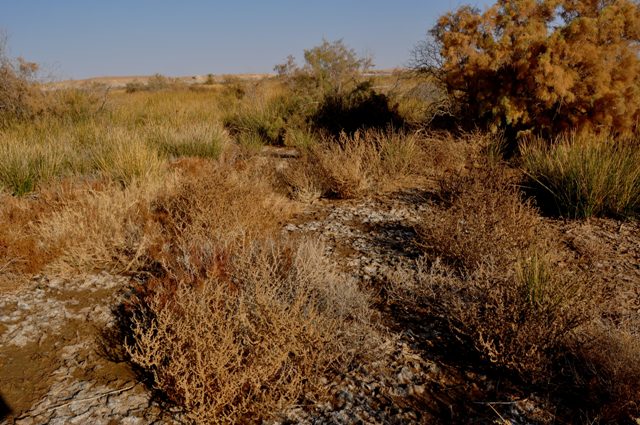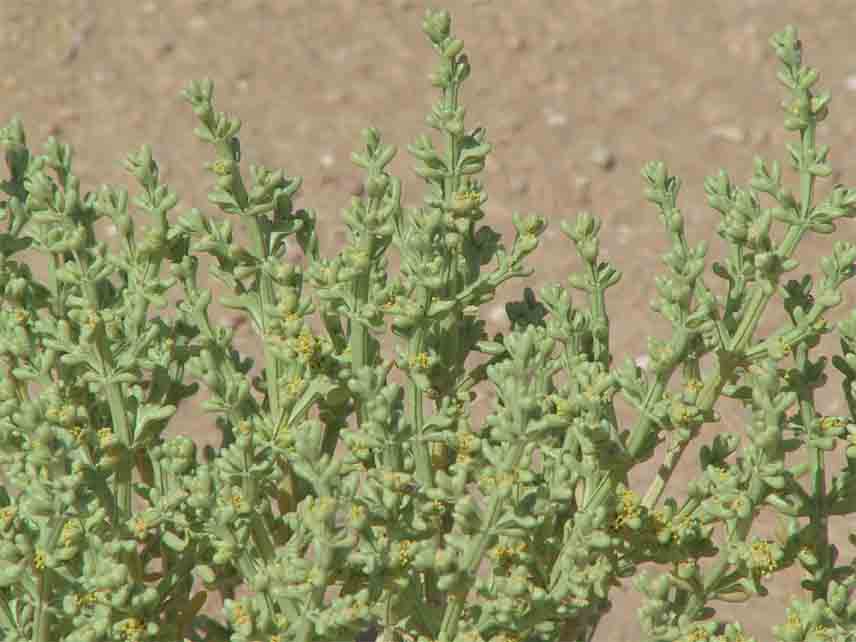Sabkhas

Sabkhas or salt marshes are generally associated with terrestrial lands that are often subjected to being flooded with rain or seawater. This water remains there for a few weeks to several months. As water evaporates from the shallow depressions, it leaves a crest of salt and thereby forming a substratum for the growth of several salt loving plants (Halophytes). The salinity of the salty lands varies from region to region and from season to season, depending upon the climate in which these sites are located. The salinity and water level decide the vegetation type of the area. Two types of salt marshes are present in Saudi Arabia, namely inland and littoral (Coastal). Inland salty areas, which are usually far away from the seashore, are small to large depressions and are characterized by shallow underground water table. In certain areas, such as Al-Awshaziyah and Al-Hassa Oasis, the ground water reaches on the substratum and forms a somewhat perennial lake of saline water. Littoral or coastal sabkhas can be seen throughout the Arabian Gulf and the Red Sea coast. Coastal salty areas are characterized by fine clay soil mixed with humus, which are carried by flash floods from inland areas. Coastal lands are sparsely vegetated, mostly dominated by mangroves and some succulent plants of the families such as Chenopodiaceae, Zygophyllaceae, Plumbaginaceae, etc. The water for the growth of such plants growing in close proximity with sea is mostly come from seawater, whereas plants growing far away from the seashore are fed by rainwater.

In certain areas of coastal salt marsh where the area is regularly inundated by tides, the composition and density of salt is low whereas in areas having high evaporation rate, the salinity level is very high. However, during rainy season, soil salinity will drastically drop due to flooding and runoff from the land coupled with heavy rainfall. Present estimates show that Saudi Arabia contains over 100 species distributed in 33 families or so. These species are either strictly halophytes or having adaptations to survive in wider ecological amplitude. Among the halophytes recorded from Saudi Arabia, the highest number is from Chenopodiaceae followed by Poaceae, Zygophyllaceae and Tamaricaceae. In Saudi Arabia halophytes are regarded as good fodder during adverse climatic conditions; some of them rich in terms of nutritive value while others have plenty of water to quench the thirst of the domesticated animals. Some of the halophytes dominating in the Red Sea coastal regions are: Avicennia marina, Rhizophora mucronata, Cressa cretica, Limonium spp., Zygophyllum coccineum, etc. whereas the halophytic species dominating in the Arabian Gulf coast are: Suaeda vermiculata, Suaeda maritima, Salicornia ?europaea, Halocnemum strobilaceum, Arthrocnemum macrostachyum, etc.
Approximately 17 halophytic communities are present in Saudi Arabia, each of which is characteristic of a particular region.
- Reed Community
- Mangrove community
- Suaeda monoica community
- Limonium axillare community
- Halopeplis perfoliata community
- Aeluropus community
- Arthrocnemum macrostachyum community
- Halocnemum strobilaceum-Salicornia europaea community
- Seidlitzia rosmarinus community
- Juncus rigidus community
- Zygophyllum community
- Anabasis setifera community
- Sporobolus spicatus community
- Nitraria retusa community
- Atriplex farinosa community
- Tamarix community
- Mixed type community
Reed Community – Vegetation dominated by reeds are common along the drainage or irrigation canals, water creeks along the coastal belts, abandoned or neglected shallow water swamps, etc. Giant reed, Phragmites australis, can form monospecific stands on such areas along with Typha domingensis. In some localities in east and central regions, apart from the above species, rushes and sedges like Cyperus rotundus, C. schimperianus, Carex divisa, Fibristylis bis-umbellata, Juncus rigidus can also be found growing in association with Phragmites australis.
Mangrove community – Two species of mangroves are found in Saudi Arabia, namely Avicennia marina and Rhizophora mucronata. The highest concentrations of mangroves are seen in the southwestern Red Sea coast and in a significant number of Red Sea islands. The density of the mangroves, particularly Avicennia marina towards the northwestern seacoast is less and is often found in small patches. A significant number of sea grasses can also be seen in association with such mangal swamp vegetation, such as Halodule uninervis, Cymodecea rotundata, Thalassia hemprichii, Halophila stipulacea, etc. Avicennia marina is also found in the Arabian Gulf coast from areas around Qatif southwards. However, due to unsustainable utilization and habitat destruction, the population of Avicennia marina is in a highly deteriorated state.
Suaeda monoica community – The highest concentration of this community is found south of Jeddah where Suaeda monoica attains a height of about 4 meters or so. In areas around Jizan plain, Suaeda monoica forms large thickets in association with Panicum turgidum, Dipterygium glaucum, Haloxylon salicornicum, Tamarix nilotica, etc. In certain parts of the Tihama plain in the southwestern region, xerophytic species such as Acacia tortilis and Leptadenia pyrotechnica are seen along with Suaeda monoica. In other places this species seen only as occasional and never forms into communities.
Limonium axillare community – This community is common along the northern and southern Red Sea coastal sabkhas, Red Sea Islands and in the Arabian Gulf coast. It is also reported as a rare component from sabkhas of the Empty Quarter. Associated species are Cressa cretica, Zygophyllum album, Halopeplis perfoliata, Suaeda vermiculata, etc.
Halopeplis perfoliata community – The habitat for this species usually seen close to the sea shores of Red Sea area and in the Tarut Island in the Arabian Gulf. Small and large populations of this species are also found near Dammam and Ras Tanura where the soil is somewhat silty and slippery with high water content.
Arthrocnemum macrostachyum community – This community found only in the Arabian Gulf coast and northern Red Sea sabkhas, especially in protected sea coast and inlets.
Aeluropus spp. community – Two species of Aeluropus are found in Saudi Arabia, namely A. lagopoides and A. littoralis. Both species are salt excretive grasses that grow in patches of mats in highly saline and moistened soil. The former is common in both coastal and inland sabkhas while the latter is usually found only in coastal sabkhas.
Halocnemum strobilaceum-Salicornia europaea community – These two species are always found together and occupy in areas where there is no Halopeplis perfoliata. This community is usually found in northern Red Sea coast and Arabian Gulf coast. The latter species sometimes seen as pure stands in both coastal and inland sabkhas.
Seidletzia rosmarinus community – This community is usually found on hummocks in or bordering inland and coastal salty areas and is absent in Red Sea coastal belt. In Wadi Hamadh, Wadi Sirhan, etc. of the central province, and the sabkhas of the Eastern Province, this species forms into large colonies.
Juncus rigidus community – A wide spread species, tolerant of high salinity, is found both inland and littoral sabkhas. Juncus rigidus has high phenotypic plasticity that it can grow in wide range ecological amplitude.
Zygophyllum spp. community – Individual species of this community is widely distributed except in high altitude areas and sand seas. Species of this group are rarely seen together. Z. coccineum and Z. simplex are common in the southwestern coastal lands, Arabian Gulf and in many inland sabkahs. A significant number of xerophytes and halophytes can be found along with this group such as Dipterygium glaucum, Panicum turgidum, Aeluropus littoralis, etc.
Anabasis setifera community – It is a succulent member of the Chenopod family, widely distributed in the sabkhas and other extra arid conditions of the Kingdom, except in deep sand and mountains. The genus Anabasis has 4 species in Saudi Arabia; of which A. articulata, another important halophyte is seen in the eastern and northern provinces.
Sporobolus spicatus community – This community is usually seen along with Aeluropus spp. community or in areas where the latter is not dominant. It is widespread in Saudi Arabia, especially in the southwestern parts of Tihama Region.
Nitraria retusa community – This community has a narrow distribution in Saudi Arabia, so reported from the northern and eastern parts of the country. It is a salt excretive shrub with obovate, succulent leaves and small yellow or white flowers and reddish, fleshy fruits.
Atriplex farinosa community – This community is often found in coastal regions or Farasan Islands, the entire northwestern and southwestern Red Sea regions. In other areas this species does not form into communities.
Tamarix spp. community – There are two common species in Saudi Arabia; of which T. nilotica has an extensive distribution throughout the Kingdom, except in deep sand and high altitude mountains. This community is common along drainage canals or on the bank of certain stagnant pools, etc. Associated plants are Phragmites australis, Typha domingensis, Xanthium strumarium, etc.
Mixed type community – This community does not have any characteristics of its own; rather it is a mixture of several species with lesser importance as far as that particular locality is concerned. A significant number of species such as Cressa cretica, Alhagi graecofum, Atriplex leucoclada, Salsola imbricata, Cyperus leavigatus, etc. are often found together in various densities.
Common Halophytes
Coastal salt land (Dry land)
Halocnemum strobilaceum Chenopodiaceae
Binertia cycloptera Chenopodiaceae
Cressa cretica Convolvulaceae
Zygophyllum simplex Zygophyllaceae
Zygophyllum coccineum Zygophyllaceae
Suaeda aegypitaca Chenopodiaceae
Suaeda vera Chenopodiaceae
Suaeda maritime Chenopodiaceae
Arthrocnemum macrostachyum Chenopodiaceae
Salicornia europaea Chenopodiaceae
Halopeplis perfoliata Chenopodiaceae
Atriplex halimus Chenopodiaceae
Limonium axillare Plumbaginaceae
Limonium carnosum Plumbaginaceae
Limonium cylindrifolium Plumbaginaceae
Inland salt land
Anabasis articulate Chenopodiaceae
Anabasis setifera Chenopodiaceae
Haloxylon salicornicum Chenopodiaceae
Chenopodium ambrosioides Chenopodiaceae
Seidlitzia rosmarinus Chenpodiaceae
Agathophora alopecuroides Chenopodiaceae
Halothamnus iraqensis Chenopodiaceae
Halothamnus bottae Chenopodiaceae
Salsola imbricate Chenopodiaceae
Tamarix nilotica Tamaricaceae
Suaeda vermiculata Chenopodiaceae
Salicornia europaea Chenopodiaceae
Aeluropus lagopoides Poaceae
Suaeda vermiculata Chenopodiaceae
Suaeda monoica Chenopodiaceae
Zygophyllum album Zygophyllaceae
Zygophyllum propinquum ssp. migahidii Zygophyllaceae
Atriplex leucoclada Chenopodiaceae
Atriplex dimorphostegia Chenopodiaceae
Reumuria hirtella Tamaricaceae
Cistanche spp. Orobanchaceae
Orobanche spp. Orobanchaceae
Alhagi graecorum Papilionaceae
Cyperus spp. Cyperaceae
Juncus rigidus Juncaceae
Marsh land (Inland)
Phragmites australis Poaceae
Juncus rigidus Juncaceae
Typha domingensis Typhaceae
Typha elephantine Typhaceae
Leptochloa fusca Poaceae
Aeluropus lagopoides Poaceae
Aeluropus littoralis Poaceae
Coastal marshes
Avicennia marina Verbenaceae
Rhizophora mucronata Rhizophoraceae